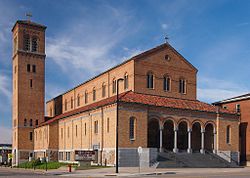Church of St. Stephen–Catholic | |
 The Church of St. Stephen viewed from the northeast | |
| Location | 103 Central Avenue S., St. Stephen, Minnesota |
|---|---|
| Coordinates | 45°42′5.5″N94°16′30″W / 45.701528°N 94.27500°W |
| Area | 2.5 acres (1.0 ha) |
| Built | 1890 (rectory), 1903 (church) |
| Architect | John Jager |
| Architectural style | Romanesque Revival |
| MPS | Ethnic Hamlet Churches–Stearns County Catholic Settlement Churches TR |
| NRHP reference No. | 82003059 [1] |
| Added to NRHP | April 15, 1982 |
The Church of St. Stephen is a historic Roman Catholic church building in St. Stephen, Minnesota, United States. It is part of the Roman Catholic Diocese of Saint Cloud. The church was constructed in 1903 in a rural community settled by Slovene immigrants. An 1890 rectory stands behind the church. [2] Both buildings were listed on the National Register of Historic Places in 1982 for their state-level significance in the themes of architecture, exploration/settlement, and religion. [3] The property was nominated for reflecting the settlement of rural Stearns County by Catholic immigrant groups clustered in small, ethnic hamlets dominated by a central church. [2]




